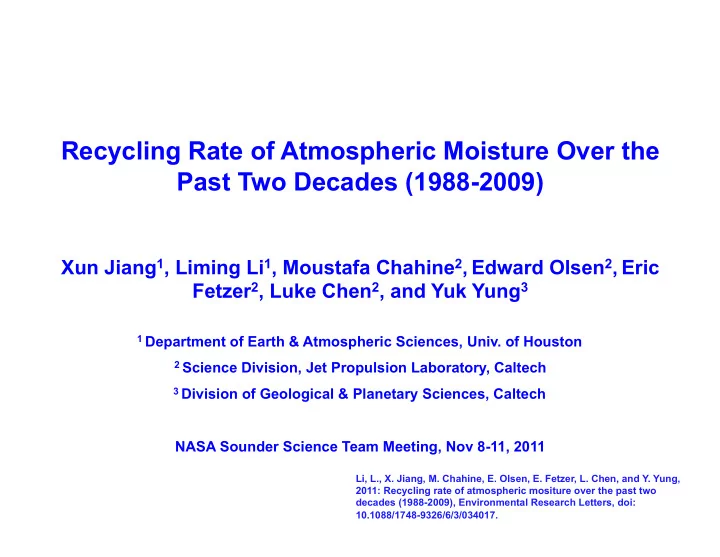

Recycling Rate of Atmospheric Moisture Over the Past Two Decades (1988-2009) Xun Jiang 1 , Liming Li 1 , Moustafa Chahine 2 , Edward Olsen 2 , Eric Fetzer 2 , Luke Chen 2 , and Yuk Yung 3 1 Department of Earth & Atmospheric Sciences, Univ. of Houston 2 Science Division, Jet Propulsion Laboratory, Caltech 3 Division of Geological & Planetary Sciences, Caltech NASA Sounder Science Team Meeting, Nov 8-11, 2011 Li, L., X. Jiang, M. Chahine, E. Olsen, E. Fetzer, L. Chen, and Y. Yung, 2011: Recycling rate of atmospheric mositure over the past two decades (1988-2009), Environmental Research Letters, doi: 10.1088/1748-9326/6/3/034017.
Overview Motivation Data Variations in Precipitation, Water Vapor, and Recycling Rate Conclusions
Motivation The recycling rate of atmospheric moisture is an important index of the climate change. Spatial patterns of temporal variations in precipitation, water vapor, and recycling rate will be helpful to understand the hydrological cycle as a response to the global warming, and provide constraints for the climate models.
Data I) Precipitation 1. Global Precipitation Climatology Project (GPCP) V2.1 -- Global Spatial: 2.5º × 2.5º; Temporal: 1979-2009 2. Special Sensor Microwave Imager (SSM/I) V6 -- Ocean Spatial: 0.25º × 0.25º; Temporal: 1988-present II) Water Vapor 1. SSM/I V6 -- Ocean Spatial: 0.25º × 0.25º; Temporal: 1988-present 2. Atmospheric Infrared Sounder (AIRS; Global) and Advanced Microwave Scanning Radiometer (AMSR; Ocean) V5 Spatial: 1º × 1º; Temporal: 2002-present 4
Recycling Rate Total Monthly Precipitation Recycling Rate = Mean Precipitable Water Vapor [Chahine et al ., 1997]
Precipitation and Water Vapor Ocean Δ P (mm/mon) Δ W (mm/mon) 60°S – 60°N (A) Deseasonalized time series of oceanic precipitation from GPCP V2.1 and SSM/I. (B) Deseasonalized time series of oceanic water vapor from SSM/I, AIRS, and AMSR-E. 6
Variations in Recycling Rate, Precipitation, and Water Vapor 7
Trends in Precipitation and Water Vapor Deseasonalized & Lowpass Filtered Timeseries SSM/I+GPCP: 0.26 ± 0.41 %/decade GPCP: 0.08 ± 0.43 %/decade SSM/I: 1.01 ± 0.39 %/decade [Li et al ., ERL 2011] 90°S – 90°N Weak linear trend in precipitation is much smaller than the linear trend (1.4 ± 0.5% per decade) in the previous study (Wentz et al., 2007).
Trends in Oceanic Precipitation, Water Vapor, and Recycling Rates Deseasonalized & Lowpass Filtered Timeseries (Ocean) SSM/I: 0.13 ± 0.63 %/decade GPCP: 0.33 ± 0.54 %/decade SSM/I: 0.97 ± 0.37 %/decade Recycling 1 = (SSM/I P)/(SSM/I W) Recycling 1: -0.82 ± 1.11 %/decade Recycling 2 = (GPCP P)/(SSM/I W) Recycling 2: -0.65 ± 0.51 %/decade 60°S – 60°N ENSO Signals have been removed by a multiple regression method.
Trend in Recycling Rate Recycling Rate1 = (SSM/I Precipitation)/(SSM/I H 2 O) � Recycling Rate2 = (GPCP Precipitation)/(SSM/I H 2 O) � Recycling Rate of atmospheric moisture has intensified in the ITCZ and weakened in the nearby areas.
Trends in Precipitation and Water Vapor Precipitation � Water Vapor � Precipitation has increased (decreased) in the high (low) precipitation areas. Magnitude of temporal variations is stronger in the precipitation than in the water vapor.
Spatial Pattern of the Mean Precipitation for 1988-2008 12
Temporal Variations of Precipitation over High & Low Precipitation Areas 3.0 ± 1.3 %/decade -4.7 ± 3.6 %/decade ENSO Signals have been removed by a multiple regression method. 13
Conclusions 1) The oceanic recycling rate of atmospheric moisture has decreased over the past two decades. Trend in the oceanic precipitation is smaller than the trend in the oceanic water vapor. AIRS global water vapor data can help better explore the global recycling rate in the future. 2) Recycling rate has increased in the ITCZ and decreased in the neighboring regions over the past two decades. 3) Temporal variation is stronger in precipitation than in water vapor, which results to the positive (negative) trend of recycling rate in the high (low) precipitation region. References: Li, L., X. Jiang, M. Chahine, E. Olsen, E. Fetzer, L. Chen, and Y. Yung, 2011: Recycling rate of atmospheric mositure over the past two decades (1988-2009), Environmental Research Letters, doi: 14 10.1088/1748-9326/6/3/034017.
Thank you! 15
Recommend
More recommend